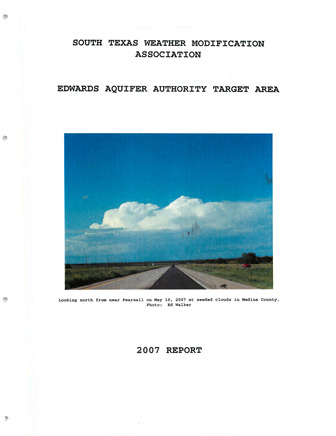South Texas Weather Modification Association Edwards Aquifer Authority Target Area 2007 Report

| Summary |
|
STWMA continued to conduct cloud seeding operations over the tri-county EAA target area in 2007, marking year number six. The past year was rather wet, with several intense rainfall episodes occurring in south-central Texas primarily in the May through August period. On several occasions event totals topped ten inches. Because of the persistent heavy rains and subsequent flooding, seeding operations were conducted on fewer days than in years past. 2007 was comparable to 2002, the last time destructive flooding occurred within the target area. Operations took place on eleven days, with cloud seeding occurring on eight of these days. This compares with 14 days of seeding in 2006, 25 days of seeding in 2005, 20 days of seeding in 2004, 22 days in 2003, and 8 days in 2002. One of, if not the best day for cloud seeding this past year was on May 10 (photo on cover) when an upper low over north-central Texas helped ignite showers and thunderstorms across the target area. Aggressive seeding of developing showers and thunderstorms took place, with several cells merging into a line that traversed the central and southern EAA target area and continued all the way to Corpus Christi by late that evening. Another day of seeding took place on the 24th. It would be nearly two months before another day of seeding would occur; a reconnaissance flight took place on July 14th but convection would die before the plane arrived. Between June and mid-August, over 20 inches of rain fell over a good portion of south-central Texas. Suspensions took their toll on seeding, with over six weeks of down time. It was a bittersweet result: Although we did not seed as many clouds as years past, the drought had come to a temporary end. Seeding operations resumed in mid-August, with the bulk of the seeding missions for 2007 taking place between August 15th and September 1st. A recon flight on September 27th would be the final flight for the EAA target area for the year. The annual evaluation conducted by Archie Ruiz at Active Influence is not available for this report. At the request of the EAA, the STWMA began a three-year experiment within the EAA target area where randomized seeding would take place. With a bit of guidance from the National Center for Atmospheric Research (NCAR), a randomization protocol was developed that would guide both the pilot and the meteorologist in conducting a randomized seeding experiment. The flight to the area of developing convection would take place and the pilot would determine if the activity was seedable based on cloud appearance, inflow strength and location. Once a seedable candidate was found, the randomized decision procedure would take place. This involves both the meteorologist and pilot opening an envelope, inside of which would be a card with either “SEED” or “NO SEED” written on it. The meteorologist would convey his envelope content to the pilot, but the pilot would not tell the meteorologist what was in his envelope. If both envelopes matched, the pilot would seed the cloud. He would continue the mission as usual, burning flares as long as conditions warranted. If the envelopes did not match, the pilot would continue to fly in the favorable location, but only “pretending” to burn flares as long as conditions warranted. By doing the randomization in this manner, only the pilot truly knows if the cloud or clouds were seeded. The cards and notes for each day were to be placed into separate manila envelopes for future analysis, the purveyor of which has yet to be determined. Radar data from each day was also to be saved, again for future analysis. There were a few exceptions to the randomization enactment. If the activity was on the edge of the target area about to exit, if the clouds were too small, or if warnings were issued, the randomized protocol was not put into effect. As it turns out, 2007 was not the best year for starting this experiment. The weather was not very cooperative, with only five of the eight days allowing for the randomized protocol to be enacted. In addition, it was not until late June before the protocol was developed. It is the hope of the STWMA that the upcoming seasons will be more favorable for continuing the randomized experiment. |
Search for Documents
Advance Search
Explore EAA's Scientific Reports
- All Reports
- Water Quality
- Climatology
- Surface Water / Groundwater Relationship
- Biology
- Springs, Groundwater Discharge
- Archaeology
- RZ Protection
- Aquifer Levels
- Remote Sensing
- Precipitation
- Overview Studies
- Modeling
- Hydrology and Hydrogeology
- History
- Groundwater Recharge, Recharge Zone
- Groundwater Movement
- Geomorphology and Caves
- Weather Modification
- Geology
- Water Use and Conservation
- Geochemistry
- Water Resources Planning and Management
- Floods and Drought
